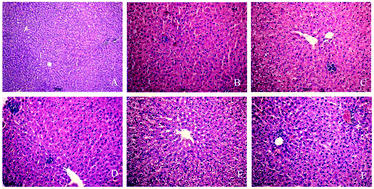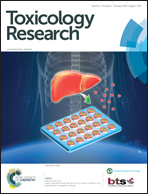Involvement of histone hypoacetylation in INH-induced rat liver injury
Abstract
This study explores the mechanism of histone acetylation under the effect of oxidative stress in rat liver injury induced by isoniazid (INH). Fifty-six adult SD rats were selected and divided randomly into INH groups (48) and control (8). Rats in INH groups were intragastrically injected with 55 mg kg−1 day−1 for 3, 7, 10, 14, 21, and 28 days, and control rats were given an equal volume of distilled water. Pathological changes in liver tissues were observed by HE staining. Western blot analysis was conducted to measure the expression levels of H3k14ac and H4k8ac. The activities of HAT, HDAC and IL-1β, and TNF-α were detected by ELISA in liver tissues. Real-time RT-PCR analysis was performed to determine the protein expression levels of HAT, HDAC, and IL-1β and the mRNA expression of TNF-α. The levels of superoxide dismutase (SOD) and malondialdehyde (MDA) were assayed by biochemical methods in liver tissues. At different time points, the SOD activity decreased, whereas the MDA content significantly increased after 14 days (FSOD = 11.15, FMDA = 7.42, P < 0.01). During this period, the expression of histone acetylated H3K14 and H4K8 acetylation decreased compared with the control group (FH3K14 = 4.18, FH4K8 = 3.87, P < 0.05); by contrast, HDAC1 and HDAC2 showed a high expression level compared with those in the control group (FHDAC1 = 29.13, FHDAC2 = 58.34, P < 0.01). Moreover, the expression of CBP/P300 was lower than that in the control group (FCBP/P300 = 12.18, P = 0.001), and the protein contents of IL-1β and TNF-α in rat liver tissues were up-regulated (FIL-1β = 44.88, FTNF-α = 41.56, P < 0.01). These results suggest that histone acetylation is involved in INH-induced rat liver injury. Furthermore, the hypoacetylation of histones H3K14 and H4K8 is negatively correlated with oxidative stress-mediated rat liver injury.



 Please wait while we load your content...
Please wait while we load your content...